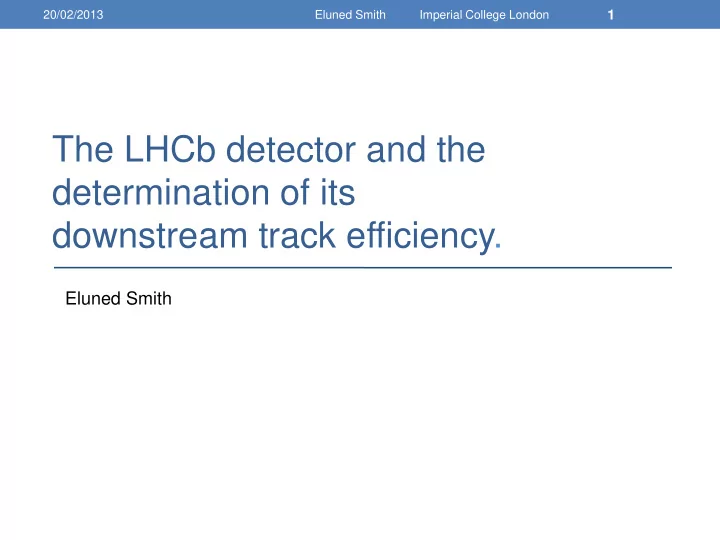

20/02/2013 Eluned Smith Imperial College London 1 The LHCb detector and the determination of its downstream track efficiency. Eluned Smith
20/02/2013 Eluned Smith Imperial College London 2 Outline • Overview of relevant parts of the LHCb detector. • What are downstream tracks? • Why do we what to better understand their efficiency? • Method proposed to determine downstream track efficiency. • Analysis carried out so far.
20/02/2013 Eluned Smith Imperial College London 3 The Large Hadron Collider (LHC)
20/02/2013 Eluned Smith Imperial College London 4 The LHCb detector
20/02/2013 Eluned Smith Imperial College London 5 • Vertex locator (VELO) ends at ~ 700mm. • Sensors ~ 7mm from the beam. • Resolution: 𝜏 𝑦, 𝑧, 𝑨 = (16,15,90) μ m . • TT tracker starts at ~ 2m. • Track must leave hits in both TT and T1,2,3.
20/02/2013 Eluned Smith Imperial College London 6 Types of tracks at LHCb. • Upstream + Downstream = Long • Events can be registered from just downstream tracks, when displaced vertex is downstream of the VELO.
20/02/2013 Eluned Smith Imperial College London 7 Motivation for improving downstream track efficiency. • Longstream track efficiency values well studied (2-3 significant figure error depending on bin). • Downstream track efficiency less well studied and understood. • Importance: Various hidden sector theories predict long- lived massive particles, which may decay beyond the VELO.
20/02/2013 Eluned Smith Imperial College London 8 Method to calculate downstream track efficiency . • Will use data from K s events (decaying to two pions) as K s relatively long-lived. • Relation between observed number ( 𝑜) and actual ( 𝑂): • 𝑜 𝑚𝑝𝑜 𝑨, 𝑞, 𝜃 = 𝜁 𝑚𝑝𝑜 𝜃, 𝑞, 𝑨 𝑂 𝑚𝑝𝑜 (𝑨, 𝑞, 𝜃) • 𝑜 𝑒𝑝𝑥𝑜 𝑨, 𝑞, 𝜃 = 𝜁 𝑒𝑝𝑥𝑜 𝜃, 𝑞, 𝑨 𝑂 𝑒𝑝𝑥𝑜 (𝑨, 𝑞, 𝜃) 𝑜 𝑚𝑝𝑜 𝑨,𝑞 • 𝑂 𝑚𝑝𝑜 𝑨, 𝑞, 𝜃 = 𝜁 𝑚𝑝𝑜 𝜃,𝑞,𝑨
20/02/2013 Eluned Smith Imperial College London 9 • Use 𝑂 𝑚𝑝𝑜 𝑨, 𝑞, 𝜃 to obtain 𝑂 𝑒𝑝𝑥𝑜 (𝑨, 𝑞, 𝜃) • Use observed counts to extract 𝜁 𝑒𝑝𝑥𝑜 𝜃, 𝑞, 𝑨 𝑜 𝑒𝑝𝑥𝑜 𝑨,𝑞,𝜃 • 𝜁 𝑒𝑝𝑥𝑜 𝜃, 𝑞, 𝑨 = 𝑂 𝑒𝑝𝑥𝑜 (𝑨,𝑞,𝜃)
20/02/2013 Eluned Smith Imperial College London 10 Analysis and progress so far. • 1 data sample of ~ 8 × 10 4 events from 2012 (about 0.2% of total data available). • 1 Monte Carlo (MC) generated sample of ~ 8 × 10 6 events. • So far have invariant mass distributions and log of number against 𝑨 for long/downstream tracks and data/MC (see slide 12) binned in momentum.
20/02/2013 Eluned Smith Imperial College London 11 𝐿 𝑡 selection . • Data sample: the life time of the 𝐿 𝑡 was required to be > 1ps. • Information from RICH particle identification is used to select pions. • In Monte Carlo only true 𝐿 𝑡 are selected. • Tracks already tagged as either long or downstream .
20/02/2013 Eluned Smith Imperial College London 12 Samples from data (left) and MC (right) for the 20- 40 GeV bin for invariant mass.
20/02/2013 Eluned Smith Imperial College London 13 Samples from data (left) and MC (right) for the 20- 40 GeV bin for number of 𝐿 𝑡 against 𝑨
20/02/2013 Eluned Smith Imperial College London 14 Conclusion and future work • Downstream track efficiency: important in searches for new long-lived particles. • Efficiency will be determined relative to long track efficiency. • Next steps: • Understand the shape of the invariant mass and 𝑨 distributions. • More cuts? • Extrapolate plots to obtain 𝜁 𝑒𝑝𝑥𝑜
20/02/2013 Eluned Smith Imperial College London 15 • Plots at http://www.hep.ph.ic.ac.uk/~es708/downstrea m_track_efficiency
20/02/2013 Eluned Smith Imperial College London 16 Overall efficiency ratio and its error, 2012
20/02/2013 Eluned Smith Imperial College London 17 Samples from data for the 0- 20 GeV bin for invariant mass.
20/02/2013 Eluned Smith Imperial College London 18 Samples from data for the 0- 20 GeV bin for log of the number of particles.
Recommend
More recommend